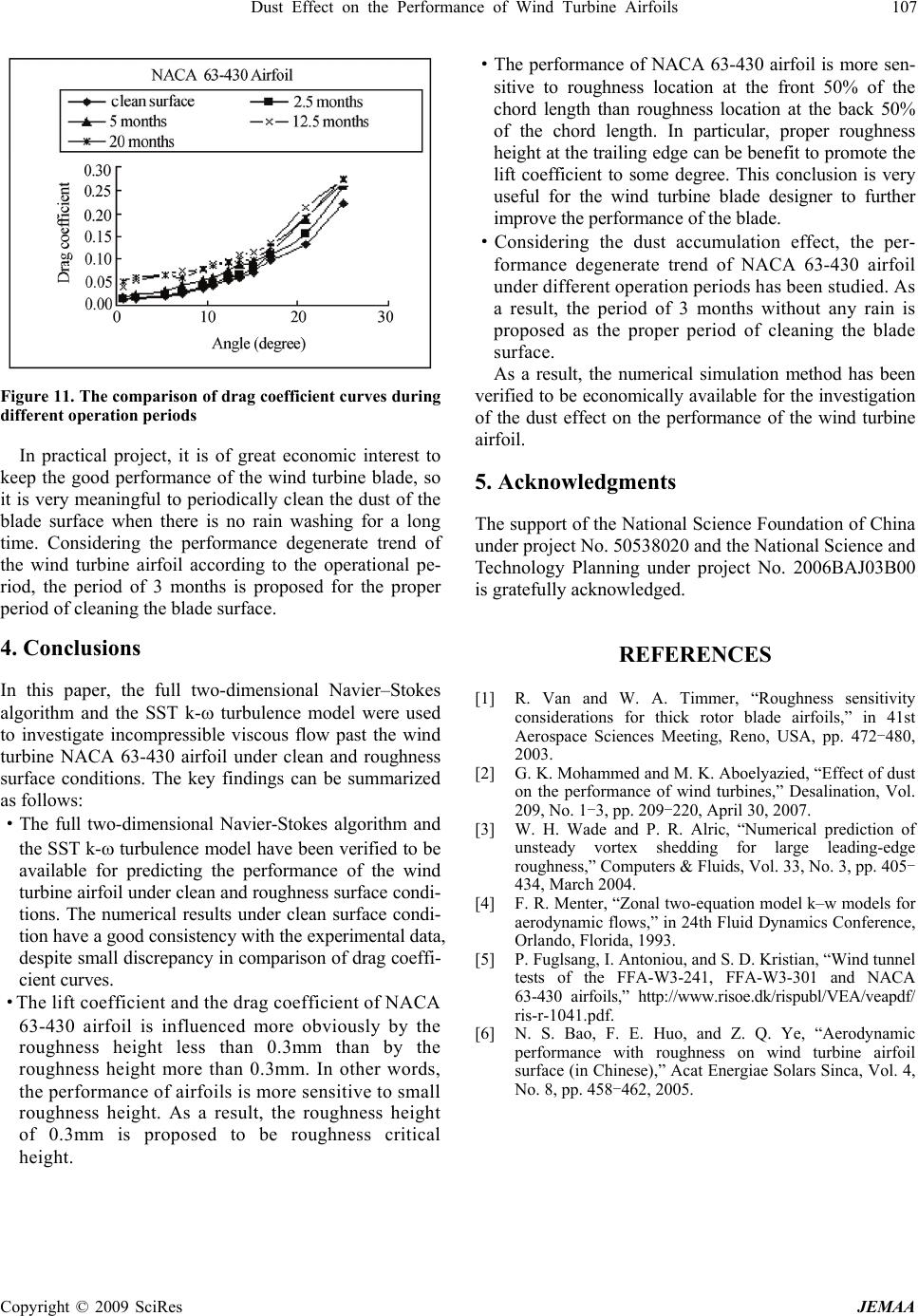
Dust Effect on the Performance of Wind Turbine Airfoils 107
Copyright © 2009 SciRes JEMAA
·The performance of NACA 63-430 airfoil is more sen-
sitive to roughness location at the front 50% of the
chord length than roughness location at the back 50%
of the chord length. In particular, proper roughness
height at the trailing edge can be benefit to promote the
lift coefficient to some degree. This conclusion is very
useful for the wind turbine blade designer to further
improve the performance of the blade.
·Considering the dust accumulation effect, the per-
formance degenerate trend of NACA 63-430 airfoil
under different operation periods has been studied. As
a result, the period of 3 months without any rain is
proposed as the proper period of cleaning the blade
surface.
As a result, the numerical simulation method has been
verified to be economically available for the investigation
of the dust effect on the performance of the wind turbine
airfoil.
Figure 11. The comparison of drag coefficient curves during
different operation periods
In practical project, it is of great economic interest to
keep the good performance of the wind turbine blade, so
it is very meaningful to periodically clean the dust of the
blade surface when there is no rain washing for a long
time. Considering the performance degenerate trend of
the wind turbine airfoil according to the operational pe-
riod, the period of 3 months is proposed for the proper
period of cleaning the blade surface.
5. Acknowledgments
The support of the National Science Foundation of China
under project No. 50538020 and the National Science and
Technology Planning under project No. 2006BAJ03B00
is gratefully acknowledged.
4. Conclusions REFERENCES
In this paper, the full two-dimensional Navier–Stokes
algorithm and the SST k- turbulence model were used
to investigate incompressible viscous flow past the wind
turbine NACA 63-430 airfoil under clean and roughness
surface conditions. The key findings can be summarized
as follows:
[1] R. Van and W. A. Timmer, “Roughness sensitivity
considerations for thick rotor blade airfoils,” in 41st
Aerospace Sciences Meeting, Reno, USA, pp. 472-480,
2003.
[2] G. K. Mohammed and M. K. Aboelyazied, “Effect of dust
on the performance of wind turbines,” Desalination, Vol.
209, No. 1-3, pp. 209-220, April 30, 2007.
·The full two-dimensional Navier-Stokes algorithm and
the SST k- turbulence model have been verified to be
available for predicting the performance of the wind
turbine airfoil under clean and roughness surface condi-
tions. The numerical results under clean surface condi-
tion have a good consistency with the experimental data,
despite small discrepancy in comparison of drag coeffi-
cient curves.
[3] W. H. Wade and P. R. Alric, “Numerical prediction of
unsteady vortex shedding for large leading-edge
roughness,” Computers & Fluids, Vol. 33, No. 3, pp. 405-
434, March 2004.
[4] F. R. Menter, “Zonal two-equation model k–w models for
aerodynamic flows,” in 24th Fluid Dynamics Conference,
Orlando, Florida, 1993.
[5] P. Fuglsang, I. Antoniou, and S. D. Kristian, “Wind tunnel
tests of the FFA-W3-241, FFA-W3-301 and NACA
63-430 airfoils,” http://www.risoe.dk/rispubl/VEA/veapdf/
ris-r-1041.pdf.
·The lift coefficient and the drag coefficient of NACA
63-430 airfoil is influenced more obviously by the
roughness height less than 0.3mm than by the
roughness height more than 0.3mm. In other words,
the performance of airfoils is more sensitive to small
roughness height. As a result, the roughness height
of 0.3mm is proposed to be roughness critical
height.
[6] N
. S. Bao, F. E. Huo, and Z. Q. Ye, “Aerodynamic
performance with roughness on wind turbine airfoil
surface (in Chinese),” Acat Energiae Solars Sinca, Vol. 4,
No. 8, pp. 458-462, 2005.